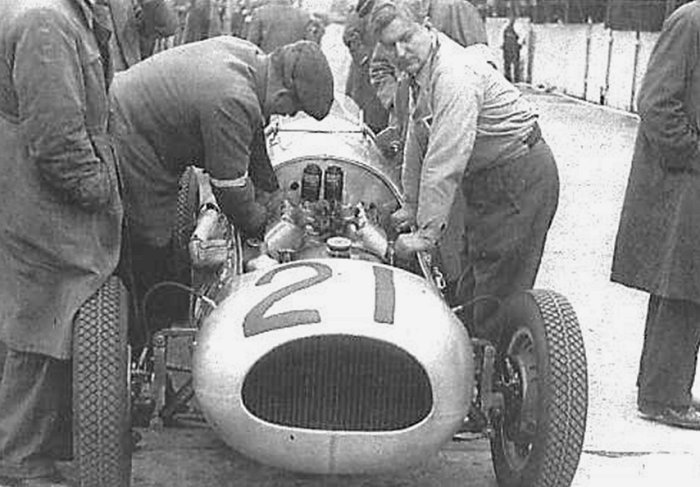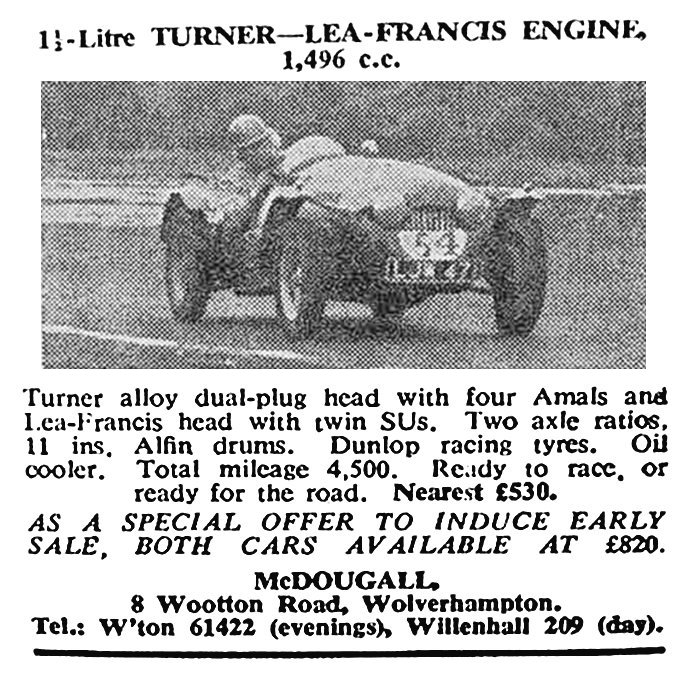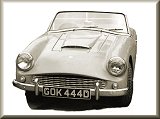| The Bardon-Turner 500cc F3 Car
Over the winter of 1949 Turner undertook a complete redesign
and rebuild of a 500cc race car for Walsall based engineer
Don Truman.
In 1947, Truman and his girlfriend
Barbara Longmore purchased one of the early Marwyn 500 race
cars which was available in component form. Despite
modifications and weight removal during assembly, the Marwyn
did not prove to be successful during the 1948 season and
more radical redesigning was carried out to make it more
competitive. For the
1949 racing season the car was entered as the Bardon
Special, the name being derived from their Christian names,
Donald and Barbara. |
|
After another frustrating
season beset with chassis and engine failures, Jack Turner was asked to further
redesign the car over the winter, ready for the 1950
season. The car was completely stripped with further
chassis modifications and weight reduction, together
with the suspension conversion to fully independent
all round. Other modifications included redesigned
twin leading shoe front brakes, and the use of light
alloy wheels together with new bodywork so that it
was now a more balanced and competitive car. For the
1950 season the car was known as The Bardon-Turner 500.
The car had a first outing at
the Easter Goodwood meeting, but that proved a
disappointing start to the year with a Did Not Finish. Things
improved with a 10th in heat for ‘Royal’ Silverstone
in May, but Prescott in June brought 4th fastest
time. At Brands Hatch a podium in the non-production
car race and finally a win at Silverstone on 2nd
July ahead of Tom Clarke's Cooper and Jack Moore's
Wasp.
|
|
At the 'Commander Yorker'
meeting, Don took a podium in the three lap scratch
race and a second to Don Parker in the
non-production car race, and Prescott in July
brought 4th fastest time. At Brands Hatch in August
the Bardon-Turner came 3rd in the non-production car
race and a second in the equivalent race in
September.
Don could only manage 8th at
Shelsley Walsh and 11th at Castle Combe and a Did Not Finish in
the 500cc race at the Grand Prix meeting, but
improved with a 5th in the handicap heat at Brough.
The last race of the year for the Bardon-Turner
brought a 5th in its heat in the Open Challenge at
Brands Hatch.
The final and least successful
evolution of the car was in 1951 when it had a new
low slung body in the style of a Cooper with pannier
tanks and a works JAP 'Sloper' engine. This new
engine should have been much more suited for circuit
racing than the old speedway JAPs but it proved
otherwise and the car failed to finish any race in
1951. Don Later received two new JAP speedway
engines from the factory by way of compensation, but
for 1952 Truman succumbed and bought a Cooper Mk.6
while Jack Turner turned his attention to his own
500cc DOHC engine unit. |
|
The Series
Sports Car Chassis
In 1950 using experience gained
on developing MG based racing specials, Turner
undertook to offer for sale a series of sports car
chassis of his own design. Chassis 001 and 002 were
road-going sports cars powered by Vauxhall engines.
A series of eight chassis were built featuring: an
'A' - formation 3 inch tubular frame, 8ft or 7ft 6in
wheelbase with 4ft track, and independent suspension
all-round using transverse leaf springs. |
|
The Ken Rose
Sports Racing Car Chassis No. 003
First registered JDA 555 at
Wolverhampton in March, 1951. The car was primarily
ordered for competition work, the chassis was fitted
with a 1767 cc Lea-Francis engine. The individual
body was styled by Abbey Panels Limited of Coventry.
The car was a regular entry in
sports racing car events on British circuits
throughout the 1950s being driven by Ken Rose and
then its second owner Dr. Toole. It is known that
on 22nd April, 1951 the car ran in an Eastern
Counties Motor Club Race Meeting at Fersfield
Airfield, Near Diss, Norfolk. |
|
Ken Rose was the son of Hugh
Rose, Chief Engineer at Lea-Francis Motors, of
Coventry. This contact led to Turner working with
Lea-Francis to develop an all aluminium version of
the LF 1767cc engine. The versatility of the design
meant that the capacity could be easily enlarged or
reduced by the choice of liners.
By 1960 the Lea-Francis engine
had been replaced by a Ford Zephyr 2,262cc,
6-cylinder engine fitted with a Raymond Mays triple
carburettor conversion. The car is now part of the
Haynes Collection and is on display at the Haynes
Motor Museum, Sparkford, Somerset. |
|
The Turner MG K3
Formula Libre Special
In 1951, ownership of John
Webb's ex-Parnell MG twin cam K3 single seat race
car transferred to Jack Turner. John Webb continued
as driver.
The book 'MG K3 Dossier' by M.
F. Hawke states: “1951 the car was sold to J. H.
Turner (who prepared the car for Webb) and the
twin-cam engine was transferred to a Turner racing
car which was raced by Webb in 1951 and 1952.”
The Parnell MG engineless
chassis was sold on. |

The Turner MG Special at the Isle
of Man Manx Cup Race in 1951. Driven by John Webb, the
car finished in 3rd position. |
|

Another view of the Turner MG
Special at the Isle of Man Manx Cup Race in 1951. Driven
by John Webb. |
|

The twin camshaft covers can
clearly be seen. |
| During 1952 the car was fitted with revised bodywork
as a result of serious accident damage during a Formula
Libre race at a Nottingham Sports Car Club event at
Silverstone. Autosport magazine reported "Leslie Marr
came very fast into Woodcote in the Formula 2 Connaught,
slid wildly to a halt in the path of Webb's Turner. Webb
could do nothing at all, and smote the Connaught
violently, the two cars remained locked together in
mid-fairway." |
| At the end of the 1952 season the car was sold to
the Rolls brothers of Newbury who raced the car during
1953 before selling it on. The twin-cam engine was
last seen racing in a car in 1954 at Davidstowe. It is
thought that the engine was transferred to a Kieft and
taken to the U.S.A. Chris Trelfall’s Sports Racer. Chassis No. 004
Built specifically for circuit racing, the car was
originally fitted with a linered-down Lea-Francis engine of 1500 cc. The
car was registered MAB 121 with Worcestershire County Council in 1953.
It was raced in several national events with moderate success throughout
the 1950s.
|
|
Ron Hill's Sports Car. Chassis No. 005
Owned and campaigned by Ron Hill, proprietor of
Hills Fibreglass Developments Limited of Wednesfield, Wolverhampton. The
car carried a Rochdale Mk 6 fibreglass body shell. The chassis was
powered by a 1,500 cc Lea-Francis based engine and ran with Turner
designed and machined magnesium alloy wheels. The car was registered 439
ORE at Staffordshire County Council in August 1954 and was entered at Shelsley Walsh and Prescott hill climbs in 1955 and 56.
|
| Wilf McDougal's Sports Race car. Chassis No. 006 |
|
Built for Wilf McDougal, proprietor of local
company Willenhall Motor Services Limited, and registered with
Wolverhampton Vehicle Licensing Department, LJW 471 on 27th July, 1953.
The car was powered by a linered-down Lea-Francis based engine to enable
it to compete in under 1,500 cc class events and was fitted with a Jack
Turner designed cylinder head featuring dual spark plugs and four AMAL
carburettors. Confirmed competition entries for the car include:
15th August, 1953 Charterhall International; 20th
June, 1954 Shelsley Walsh hill climb; 2nd August, 1954 Brands Hatch
International;
19th June, 1955 Shelsley Walsh National Speed Hill
Climb.
|
|

The car was advertised for sale in Autosport Magazine on 20th
January, 1956. |
 |
|
 |
Return to
Part One |
|
Proceed to
Part Three |
|